IMMERSE YOURSELF IN ROYAL SPLENDOUR AND OPULENCE IN JAIPUR
Deeply intertwined with the history and culture of Jaipur City, the City Palace lies as an embodiment of beauty and elegance. The ornate structure of the Palace incorporates a charming seven-story building along with antique museums, extensive courtyards, lavish rooms, manicured gardens and beautiful archways. All-in-all, the citadel is well-curated and forged to perfection.
The City Palace, made of red and pink sandstone- showcases a blend of Mughal and Rajput architectural marvels along with a hint of European style. Maharaja Sawai Jai Singh built this Palace during the years- 1729 to 1732. The City Palace is still home to the present royal family of Jaipur, who exclusively resides in the Chandra Mahal complex of the Palace.
HISTORY
The City Palace’s history is deeply interlaced with the chronology and culture of Jaipur City at large. Maharaja Sawai Jai Singh II, the founder of Jaipur City and the head of the Kachwaha Rajput clan, holds credit for the construction of the City Palace during the 17th century.
During the reign of Maharaja Jai Singh II, the town of Amer and the majestic Amber Fort were the capital of the state and the residence of the royal family. However, as the population grew and water became scarce, the Maharaja decided to set up a new capital, which resulted in the erection of the magnificent City Palace and the City of Jaipur altogether.
Maharaja Jai Singh II commissioned two extremely talented architects for the building of the City Palace together with the entire City of Jaipur; Vidhyadhar Bhattacharya, a Bengali architect and Sir Samuel Swinton Jacob, a colonial engineer and architect. It is unnecessary to emphasize a job well done, as the City of Jaipur came out as an architectural utopia and still amasses tourists at large.
The Raja’s death followed several wars between the Rajput kings. As with time Maharaja Ram Singh joined forces with the British during the Revolt of 1857 and proceeded to transform the city into a medley of pink structures, in order to welcome the Prince of Wales. This resulted in the terminology as ‘Pink City’ for Jaipur. Jaipur remained the capital of the kingdom until 1949. The adopted son of Maharaja Madho Singh II- Raja Man Singh II was the last king to rule from the Chandra Mahal Palace.
In 1949 it became the capital of the present-day Indian state of Rajasthan, with the City Palace functioning as the ceremonial and administrative seat of the Maharaja of Jaipur and to date, continues to do so.
GEOGRAPHY:
The palace complex lies in the heart of Jaipur city, to the northeast of the very centre, located at 26.9255°N 75.8236°E. Sprawling and grand, the City Palace is laid in a unique pattern with wide avenues and consists of special complexes, several courtyards, buildings, pavilions, gardens and temples.
ARCHITECTURE:
Jaipur City, an epitome of architectural and cultural grandeur, is the first “planned” city in India. The vast complex of the City Palace occupies one-seventh of the walled city. The architectural style of City Palace is a beautiful medley of Rajput, European and Mughal styles. Built out of red and pink sandstone, this palace has vast courtyards surrounded by several arched smaller Palaces.
LAYOUT:
The essential highlights of the place include the Chandra Mahal, the Mukut Mahal, the Shri Govind Dev Ji Temple, the Maharani’s Palace, the Mubarak Mahal, and the City Palace Museum.
Govind Dev Ji temple
Govind Dev Ji temple, dedicated to the Hindu God Lord Krishna, is part of the City Palace complex.
Entrance gates
The Udai Pol near Jaleb Chowk, the Virendra Pol near Jantar Mantar – which are used by the public and the Tripolia (three pols or gates)- reserved for the royal family, are the three main entry gates of the City Palace.
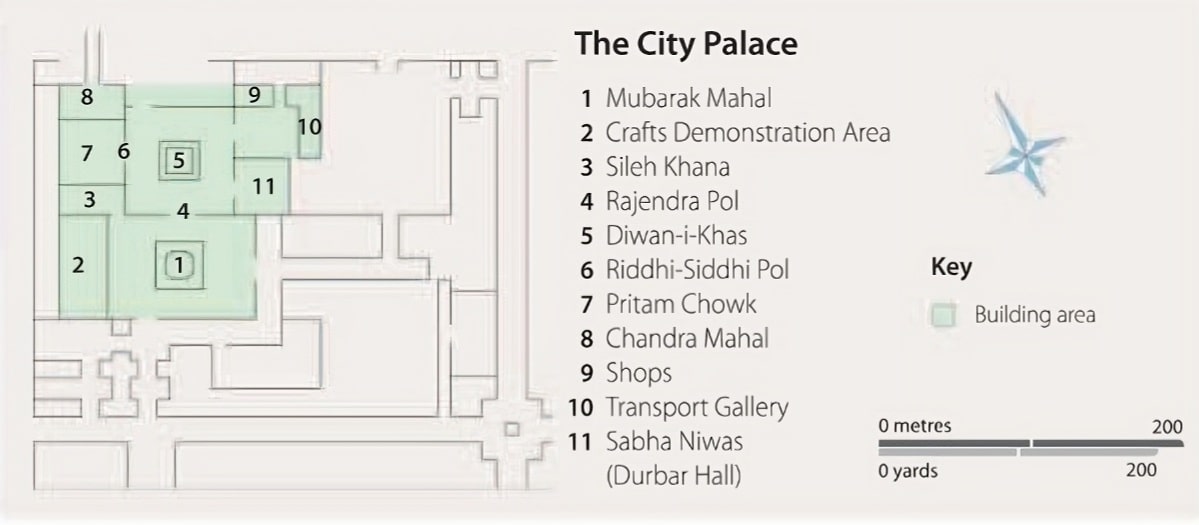
Mubarak Mahal/Welcome Palace
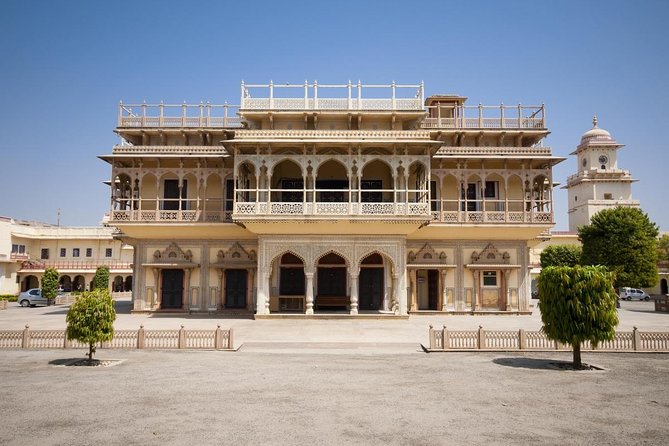
This sandstone Palace was built in 1900 by Madho Singh II to receive guests, hence the name. It is now the costume and textile gallery. In the past, this was a reception centre for visiting dignitaries.
Sileh Khana/Arms Gallery
The former armoury houses the museum’s collection of weapons, some lavishly decorated and is considered among the finest in India.
Rajendra Pol

Flanking the gateway are two large-sized elephant statues, each carved from a single block of marble.
Diwan-i-khas
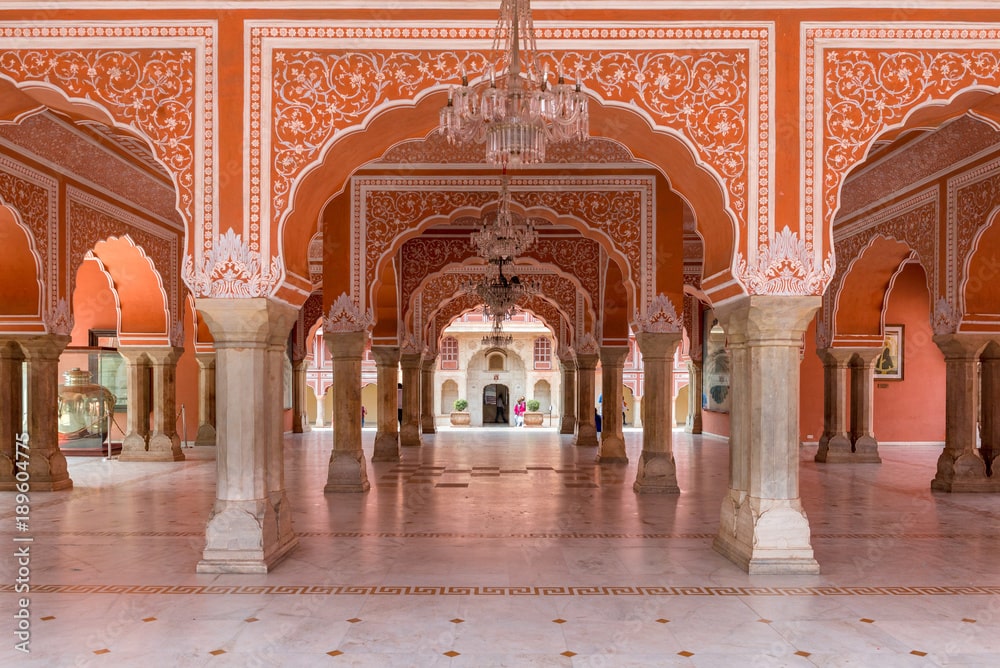
A single-storeyed, square and open hall, with enclosed rooms at the four corners, where the ruler could hold court with the officials and nobles of the kingdom in a more private, intimate space.
Pritam Niwas Chowk/Court of the Beloved
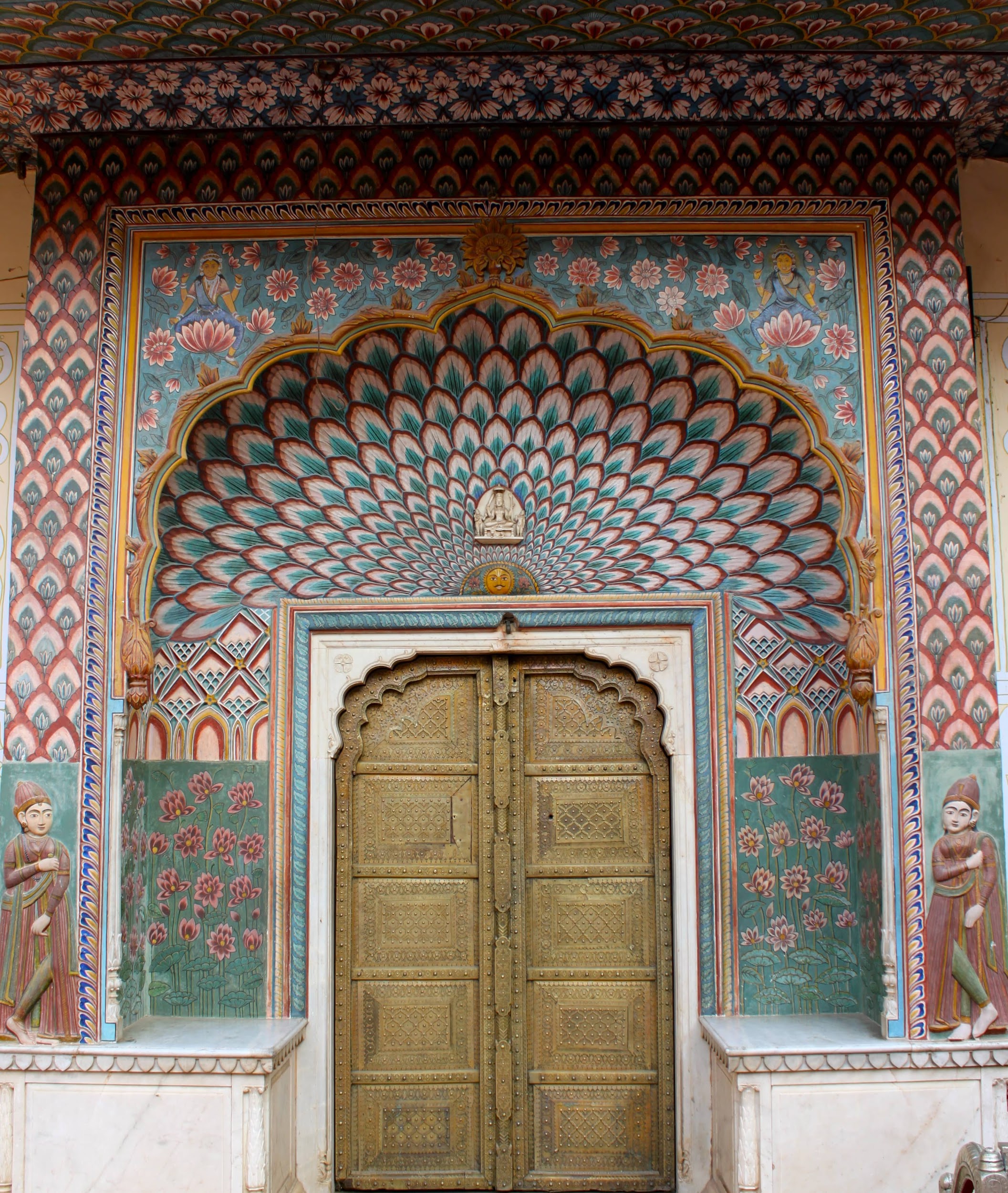

The “Court of the Beloved” has four delicately painted doorways (known as Ridhi Sidhi pol) that are adorned with themes representing the four seasons and Hindu gods.
Chandra Mahal/Moon Palace
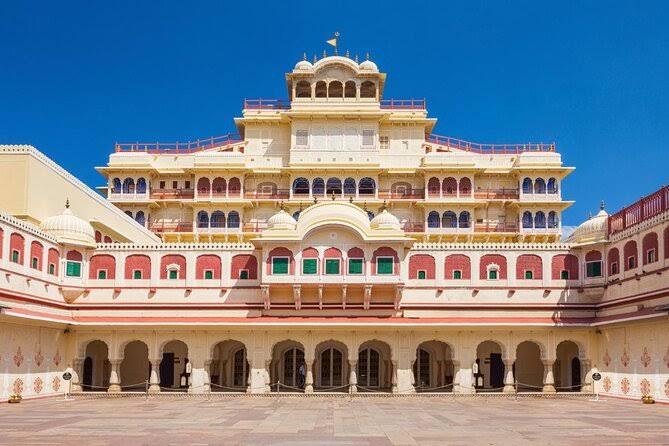
Located in the northwest of the vast City Palace, each floor of this seven-storeyed Palace is extravagantly decorated and has a specific name according to its function. Completed in 1734, the top floor of the Palace offers beautiful city views.
The Ground and First Floors:
The ground and first floors of the palace house the extensive art collection of the Maharaja Sawai Man Singh II Museum.
Sukh Niwas (Hall of Pleasure):
The second floor has an open terrace.
Sukh Kanwar:
Possibly built in honour of Sawai Jai Singh’s beloved queen, it is decorated with colourful floral designs and Mughal miniatures.
Rang Mandir (Temple of Colour):
The third floor is embellished with mirrors on the walls, pillars, exquisite blue tiles and gold leaf designs within the wall and ceilings.
Shobha Niwas (House of Beauty):
The fourth floor, similar to the third floor, also consists of exquisite blue tiles and gold leaf designs on the wall.
Chhavi Niwas (Hall of Images):
The fifth floor is decorated with blue-and-white painted floral designs and was the Maharaja’s retreat during the rainy season.
Sri Niwas (Shining Hall):
The sixth floor offers mirrored ceilings and rows of double columns through which there are magnificent views of the hills and city.
Mukut Niwas (House of the Crown):
Finally, the top floor is an open marble pavilion affording panoramic views of the walled city.
Transport Gallery:
A comparatively recent addition is the Transport Gallery which exhibits palanquins, chariots, ikkas, buggies and carriages from the old Buggi Khana, which later fell into disuse after the motor car became popular with the maharajas.
Sabha Niwas(Darbar Hall):
Also sometimes referred to as Diwan-e-Aam, the hall was built during the reign of Maharaja Sawai Pratap Singh (1778–1803). Sparkling glass mirrors embellished with intricate designs are among the many stunning features in the Durbar Hall.
TOURISM:
BEST TIME TO VISIT JAIPUR CITY PALACE:
Morning and late afternoon are the prime time. Month-wise, between March – April due to the warm, pleasant weather and October – February, when the weather is cold and dry.
HOW TO REACH:
The City Palace is easily accessible by auto-rickshaw, taxi or cycle rickshaw or Metro (get off at Badi Chaupar station).
TIMING:
9:30 AM to 5:00 PM and 7:00 PM to 10 PM for night visits. Open every day (except national holidays, Holi and Diwali).
ENTRY FEES:
For Indian Nationals
[table id=11 /]
For Foreign Nationals
[table id=12 /]
NOTE: If you’d like to gain access to the upper floors of the City Palace, including the famous blue rooms, you’ll need to purchase the hefty Royal Splendour ticket. The ticket includes access to the upper floors of Chandra Mahal, along with a private guide and a complimentary chai.
THINGS TO KNOW:
- Carry a water bottle, as it is a vast complex, therefore there is a lot to walk and see.
- Photography is allowed within the palace premises with a fee: of INR 50, and Videography: is INR 150
- Carry your government ID Proof if you want to rent an audio guide.
- Enquiry for guides and other information is available at the entrance.
- Dress comfortably along with flat footwear and good shoes, which will offer an easier experience.
- City Palace, Jaipur is disable-friendly.
If visiting Jaipur, City Palace offers a sneak-peak into the life of the royals along with their history, culture, and beliefs and not to forget the magnificent architecture on display throughout the palace, which all adds up to a mesmerising visit.
FREQUENTLY ASKED QUESTIONS
Q. Who currently resides in the City Palace, Jaipur?
Maharaja Padmanabh Singh; his mother, Princess Diya Kumari, Maharani Padmini Devi; and the maharaja’s siblings, Princess Gauravi Kumari and Lakshya Raj Singh, consist of the immediate members of the royal family.
Q. What is the best time to visit City Palace, Jaipur?
Morning and late afternoon are the prime time. Month-wise, between March – April due to the warm, pleasant weather and October – February, when the weather is cold and dry.
Q. Is photography allowed within City Palace, Jaipur?
Photography is allowed within some areas of the City Palace with a fee of Rs 50 and Rs 150 for videography but is strictly prohibited inside the museums.


